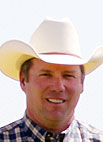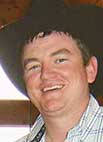 Mike and Malinda Taylor own, and along with their three sons operate, Horsehead Ranch in Talala, Okla. They are Brangus seedstock producers raising and selling purebred Brangus bulls and fancy replacement heifers. Ranching is Mike’s passion; he is a fourth generation farmer and rancher. His great grandfather’s brand was the horsehead dating back to the beginning of Oklahoma’s statehood. Mike not only continues to use the horsehead brand but also named his ranch after it.
Mike and Malinda Taylor own, and along with their three sons operate, Horsehead Ranch in Talala, Okla. They are Brangus seedstock producers raising and selling purebred Brangus bulls and fancy replacement heifers. Ranching is Mike’s passion; he is a fourth generation farmer and rancher. His great grandfather’s brand was the horsehead dating back to the beginning of Oklahoma’s statehood. Mike not only continues to use the horsehead brand but also named his ranch after it.
He started raising registered Brangus in 2000, stating that you will typically see the Brangus breed in Kansas, Missouri and to the south. Brangus cattle are heat tolerant, growthy and have gentle dispositions. Good dispositions are a top priority for Mike’s herd because it is always important when working with them.
There are a lot of risks involved in ranching and managing those risks are important. A portion of risk management comes in the timing of calving season at Horsehead Ranch. Mike prefers spring and fall calving seasons and not to have his cattle bred to calve in the winter cold or summer heat to prevent any issues of calving in a blizzard or in triple digits. He suggested many ranchers turn out their bulls in mid-May to begin spring breeding season and in mid-December for fall calving season after the bulls have been fertility tested and all cattle have been dewormed and vaccinated. Mike recommended annual fertility testing of your bulls especially in the springtime, 30 days or so before breeding season starts because winters can be very tough on your bulls, as well as, the hot summer months can make bulls temporarily sterile. Fertility testing, as well as, good genetics especially in your herd bulls is a small investment when you consider all of the other costs for producers and is also an important portion of risk management.
The tough drought conditions the last two years have resulted in higher feed costs. Mike added that keeping good cattle records is a necessity to increase efficiency on the ranch. He stated that it is always important to cull any less-productive cows, older cows or any slow breeders. At the same time it is good to stay on top of all pasture management such as weed spraying to soil sampling and fertilizing to help boost quality and quantity of grass pastures. Mike raises the hay they feed their cattle, and purchases protein cubes and feed supplements for his herd. Proper animal nutrition, though costly, will help boost your bottom line including quality minerals being top dressed on feed as well as being offered free-choice year round.
Freeze branding is Mike’s personal preference for identification purposes from monitoring his herd in pastures for record keeping. The holding brand that identifies Mikes herd is a Horsehead, the animal’s number is below that and the birth year is on the third line. Freeze branding is also an excellent deterrent against theft because of its high visibility on the black cattle. Mike also suggested feeding your herd at a distance from any pens next to roads to help prevent theft of your stock. These are also good risk management techniques that will help producers as cattle thieves look for easy targets that can’t be traced.
Finally risk management comes in many forms and maintaining good fences is always important, but so is keeping cattle out of bottom ground that is prone to flooding after heavy rains. There are many challenges in cattle ranching but seeing a newborn calf outweighs most all of the tougher times and challenges.
Mike’s best advice when taking on everything from daily chores to projects is that, “it doesn’t matter where you start as long as you get started” and for those really big projects, “you eat an elephant one bite at a time.”







